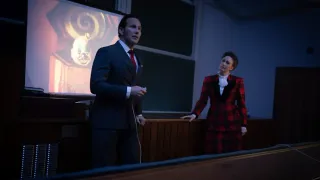
5 hours ago
Gay Influencer Couple Finds Pride and Purpose in Small-Town Living
READ TIME: 25 MIN.
When most people think of LGBTQ+ community, images of bustling urban neighborhoods—rainbow crosswalks, thriving nightlife, and large-scale Pride festivals—often come to mind. However, a growing number of queer individuals and couples are choosing to live in smaller towns, bringing visibility and advocacy to places that historically have seen less LGBTQ+ representation. Among them is a gay influencer couple recently profiled by Queerty, who have made it their mission to challenge assumptions and foster inclusivity in their small Southern town .
PJ McKay and Thomas McKay, known online as @pjandthomas, have amassed a significant following by documenting their lives as husbands and dads in Tennessee. Their social media channels offer glimpses into home renovations, parenting, and everyday moments, all set against the backdrop of their small hometown . With over 750,000 Instagram followers and a popular YouTube channel, their influence extends well beyond their local community.
In a recent conversation with Queerty, the couple explained their commitment to small-town living: “We both grew up in the town we live in now, and being here allows us to be visible for people who might not see LGBTQ+ families in person otherwise,” Thomas said . For PJ and Thomas, their presence is not just about comfort or nostalgia; it is a deliberate choice to challenge stereotypes and create opportunities for connection and understanding.
LGBTQ+ visibility in rural and suburban areas remains a critical issue. National advocacy organizations, including the Human Rights Campaign, have noted that queer people living outside urban centers often face higher rates of isolation and discrimination, but also possess unique opportunities to foster acceptance through personal connections .
PJ and Thomas recognize the power of their platform. “We want people to know that being gay isn’t just an urban experience,” PJ shared. “There are LGBTQ+ people everywhere, and our lives aren’t defined by where we live, but by the love and family we build” .
Their decision to remain in a small town is also a form of activism. By living openly, raising their children, and engaging with their neighbors, they provide a counter-narrative to the misconception that queer people cannot thrive outside large cities. Their followers frequently comment on how their story has helped normalize LGBTQ+ families for those in conservative regions .
The couple’s experience reflects broader trends identified by LGBTQ+ researchers and activists. According to a June 2025 report by GLAAD, increased social media engagement has allowed queer influencers in rural areas to connect nationally and globally, fostering solidarity while also encouraging local acceptance .
PJ and Thomas frequently use their platforms to spotlight local issues, support community events, and invite conversations about diversity and acceptance. Their willingness to share both the joys and challenges of small-town queer life resonates with many who feel unseen in their own communities. “We get messages from people saying, ‘I didn’t know there was a gay couple in my town until you posted about the local parade,’” Thomas said .
While their story is one of hope, PJ and Thomas acknowledge that living as a visible queer couple in a small town is not without its risks. According to the Movement Advancement Project, legal protections for LGBTQ+ people vary widely by region, and rural communities can be slow to adopt inclusive policies . Yet, the couple emphasizes the importance of local allies and networks, noting that community support can be a powerful tool for change.
Their advocacy extends beyond social media. PJ and Thomas have partnered with local schools and organizations to promote anti-bullying campaigns and support LGBTQ+ youth. “If even one kid feels less alone because they see our family, it’s worth it,” PJ said .
As Pride celebrations continue to expand beyond urban centers, stories like PJ and Thomas’s serve as a reminder that queer life is not monolithic. Their commitment to small-town living challenges the perception that LGBTQ+ people must leave rural communities to find acceptance and happiness. Instead, they demonstrate that visibility, advocacy, and love can flourish anywhere.
Their journey offers hope to LGBTQ+ individuals considering similar paths. As Thomas concluded in his interview, “We want our kids—and everyone’s kids—to grow up knowing that being yourself is possible no matter where you are. Change starts with someone willing to be seen” .
For many in the LGBTQ+ community, the courage to live authentically in small towns is paving the way for a future where pride is truly everywhere.






